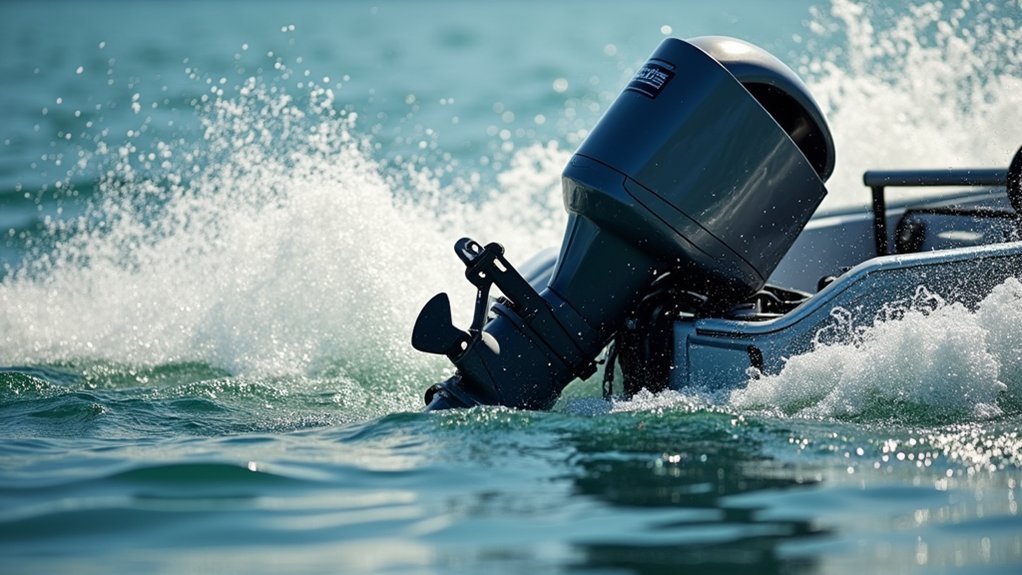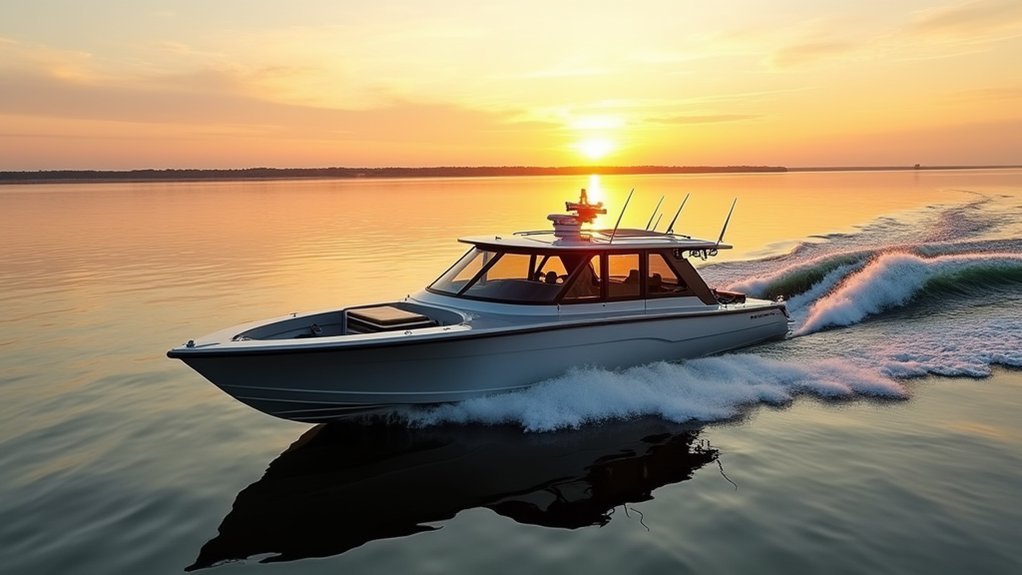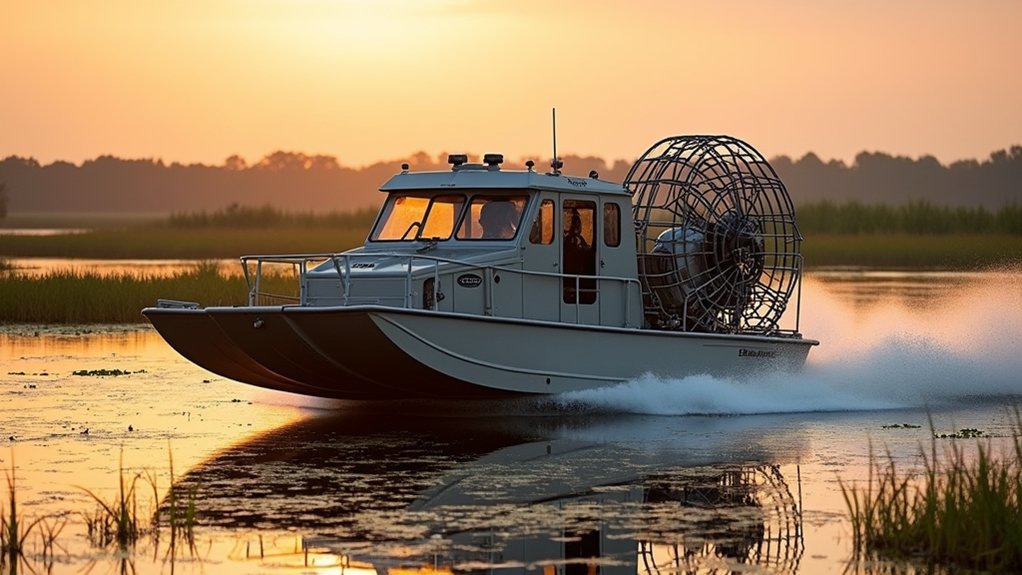When we're talking about shallow water drives, it's not just one feature that makes them excel – it's a whole system working together. We'll explore how specialized hull designs, innovative propulsion systems, and smart engineering create boats that can navigate skinny waters with ease. From tunnel-V bottoms that practically glide over the surface to advanced propeller designs that maintain thrust in thin water, there's plenty to uncover about these remarkable machines.
Design Elements That Enhance Shallow Water Performance
Several key design elements work together to create superior shallow water performance in modern boats. We're seeing innovative features like tunnel-V hulls with steep angles that let's glide smoothly over shallow obstacles while maintaining stability.
When we combine these hulls with surface drive systems, we eliminate deep-running propellers that could get damaged in skinny water. We've found that installing an extended jack plate gives us the freedom to raise our outboard motor higher, improving clearance in tricky spots.
For even better handling, we're using trim tabs and hydrofoils that help keep the bow up at low speeds. Today's shallow water boats also benefit from lightweight composite materials that reduce draft while maximizing how much weight we can carry.
Key Engineering Features for Maximum Efficiency
While traditional boat motors rely on standard propellers, modern surface-drive systems take shallow water performance to the next level through innovative engineering.
We're seeing amazing advances in how surface-drive motors handle challenging conditions through their specialized curved-blade designs and adjustable trim capabilities.
The direct-drive impeller system lets us maximize water flow and thrust, while smart intake grates keep debris out without sacrificing performance.
When we combine these features with lightweight materials like carbon fiber and aluminum, we've got a system that's incredibly efficient in shallow water.
These engineering breakthroughs mean we can access spots that were once off-limits, all while maintaining better speed and control than ever before.
The result? We're getting more power and reliability exactly where we need it.
Power Delivery and Propulsion Systems

The power delivery system forms the heart of any shallow water drive, building on those specialized engineering features to create ideal performance. We've found that the most effective systems use direct power transfer, minimizing energy loss between the engine and propeller. This means we'll get more thrust and better control when navigating traversing tricky shallow water conditions.
They're designed to maintain excellent thrust even when we're skimming across skinny water. The key is in how they deliver consistent power while preventing cavitation – those pesky air bubbles that can rob us of performance. By combining smart power delivery with specialized propellers, we're able to achieve that perfect balance of speed and control.
Material Selection and Durability Factors
Material choices make all the difference in how well a shallow water drive performs and lasts over time. We're seeing more manufacturers turn to corrosion-resistant materials like stainless steel and aluminum to protect against water exposure, especially in challenging saltwater environments. Let's look at what makes these drives so tough.
When we combine these durable materials with reinforced propeller shafts and specialized protective coatings, we're creating systems that can handle the demands of shallow water navigation. Today's advanced manufacturing techniques, including precision CNC machining, let's build components that are both lighter and stronger than ever before.
It's not just about surviving in harsh conditions – it's about giving you the freedom to explore those hard-to-reach fishing spots without worrying about equipment failure.
Weight Distribution and Balance Optimization

Ideal weight distribution plays three critical roles in shallow water drive performance – stability, control, and efficiency. We'll show you how proper balance optimization can transform your shallow water experience. By positioning heavier components like your outboard motor and fuel tank low and centered, you'll achieve better handling in skinny water.
| Component | Suitable Position | Performance Benefit |
|---|---|---|
| Motor | Low & Centered | Enhanced Stability |
| Fuel Tank | Midship & Low | Better Balance |
| Trim Tabs | Stern Quarters | Improved Lift |
| Hull Weight | Even Distribution | Reduced Draft |
Let's explore how strategic weight placement makes all the difference. When we combine proper motor mounting with carefully positioned trim tabs and sponsons, we're maximizing our boat's potential. Remember, lighter overall weight means better shallow water performance, so every component's position matters.
Propeller Technology and Configuration
Modern propeller design revolutionizes how effectively we can navigate shallow waters. We've discovered that surface-drive propellers with specialized configurations deliver superior performance when paired with stainless steel construction. Let's explore why these technological advances matter for your boating freedom.
Higher blade counts (3-4) with cupped designs generate more thrust and efficiency than traditional 2-blade props. Stainless steel construction means you'll breeze through debris without worrying about damage. Larger diameter props (13-15 inches) maximize your speed potential in shallow conditions. Interchangeable props let you customize performance based on your boat's weight and power.
These advancements aren't just about better engineering – they're about giving you more control and confidence when you're exploring those hard-to-reach spots that other boats can't access.
Environmental Adaptability and Terrain Response

The remarkable adaptability of shallow water drives shines through when encountering diverse terrains and challenging environments. We've seen how these drives excel in shallow waters where other motors struggle, maintaining strong shallow water performance even when traversing through mud and debris. Their shallow draft design lets us venture into areas that would normally be off-limits, opening up exciting new possibilities for exploration.
What's particularly impressive is how these drives respond to sudden depth changes. When we're cruising through varying water levels, the system automatically adjusts to protect both the propeller and engine. This smart design means we don't have to constantly worry about hidden obstacles or shifting sandbanks – the drive handles these challenges while keeping us moving forward smoothly and safely.
Frequently Asked Questions
Is Inboard or Outboard Better for Shallow Water?
We'll get better shallow water performance from inboards since their hull design and engine placement allow deeper propeller immersion. While outboards offer greater maneuverability and fuel efficiency, they're more vulnerable in skinny water.
Are Jet Drives Good for Shallow Water?
We'll get great shallow water boat handling with jet drives. Their maneuverability in tight spaces is excellent, though they need more engine power. Maintenance's simpler without props, perfect for adventurous boating.
What Is the Difference Between Deep Water and Shallow Water?
We'll find deep water past 20 feet with steady water flow, while shallow water's under 10 feet where bottom conditions really matter for boat maneuverability. It's like two different worlds.
What Is a Shallow Water Drive?
We'll find a shallow water drive gives us efficient propulsion in skinny water with minimal draft. It's a specialized outboard system offering quiet operation and responsive handling in places others can't reach.